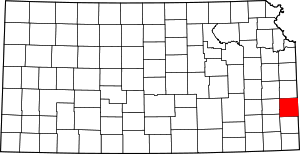






Please add profiles of those who were born, lived or died in Bourbon County, Kansas.
History
The Great Plains of North America were inhabited by nomadic Native Americans. From the 16th century to 18th century, the Kingdom of France claimed ownership of large parts of North America. In 1762, after the French and Indian War, France secretly ceded New France to Spain, per the Treaty of Fontainebleau.
In 1802, Spain returned most of the land to France, but keeping title to about 7,500 square miles. In 1803, most of the land for modern day Kansas was acquired by the United States from France as part of the 828,000 square mile Louisiana Purchase for 2.83 cents per acre.
In 1854, the Kansas Territory was organized, then in 1861 Kansas became the 34th U.S. state. In 1855, Bourbon County was established.
Bleeding Kansas
Two years after the army abandoned Fort Scott, the buildings were sold by auction to civilians, with two being converted to hotels. In 1854 the Kansas–Nebraska Act repealed the Missouri Compromise of 1820, which had kept slavery out of Kansas. Missourians in favor of slavery soon moved to Kansas to try to sway the vote of whether or not Kansas would permit slavery. Settlers from New England arrived equally determined to keep it out. Each of the two competing factions of the Bleeding Kansas conflict claimed one of the hotels at Fort Scott: Free-Soil at the Fort Scott Hotel and Pro-Slavery at the Western Hotel. Most of the residents in Fort Scott supported slavery, but those outside the town tended to the free-soil side. During this time, there were local incidents of murder and attempted arson, typical elements of the guerrilla conflicts that were prevalent in the fighting.
The American Civil War
During the American Civil War, the fort was renewed as a US military post. In August 1861, the Union Army took command of Fort Scott, and readied it for the war times. The United States Army also took over several blocks within the town for commissary and quartermaster functions. The Union Army rented the properties from the current civilian owners. Troops from Indiana, Iowa, Colorado, Ohio, and Wisconsin would come to the fort, and either stayed by the fort, or traveled farther, to subjugate Missouri, Arkansas, or the Indian Territory. Fort Scott was one of the few installations that recruited and trained black soldiers for the United States Colored Troops of the Union Army.
A major supply depot was situated at the fort. Confederate general Sterling Price hoped to capture the town, but the closest the Confederate force came to the garrison was 10 miles away at Battle of Dry Wood Creek. The site was strategically important as it was within a Southern-sympathizing area and close to the Confederate state of Arkansas and the "unstable" Indian Territory (present-day state of Oklahoma), where many of the members of the Five Civilized Tribes were allied with the Confederates. The fort served as a "general hospital" (large military hospital) and prison until after the war. Following the end of the war, in October 1865 the US Army left the facilities and sold off by auction what they controlled.
On January 14, 1870, the Army returned with the formation of the Post of Southeast Kansas. The Post was based at Fort Scott, but the soldiers camped along the rail tracks, and seldom used the original fort. They were sent to protect the railroads and workers from settlers. Some of the latter feared that the railroad, which had been awarded land for development by the US Government in rights-of-way, would evict them from their squatter homes. The settlers considered the troops lackeys to the railroads, and lumped both as enemies.
Settlers also had some continuing conflicts with Indians and insurgents using the recent Confederate cause as excuse for robbery. By the spring of 1873, the US Army withdrew the troops from Fort Scott for good. From 1873 to 1965, the buildings of the fort were left unattended, and slowly deteriorated. Many military buildings were razed and replaced with structures built for civilian use.
Bourbon virus, a new strain of thogotovirus, was first discovered in Bourbon County. In the spring of 2014 an otherwise healthy man was bitten by a tick, contracting the virus, dying 11 days later from organ failure.
Adjacent Counties
Cities, Townships & Communities
Barnesville | Berlin | Bronson | Devon | Drywood | Fort Scott (County Seat) | Franklin | Freedom | Fulton | Garland | Godfrey | Hammond | Harding | Hiattville | Hidden Valley | Hollister | Mapleton | Marion | Marmaton | Mill Creek | Osage | Pawnee | Pawnee Station | Redfield | Ronald | Scott | Timberhill | Uniontown | Walnut | Xenia
Links
Fort Scott National Historic Site
National Register of Historic Places
Bourbon County Genealogical Research
